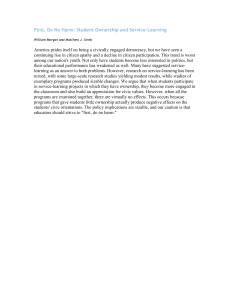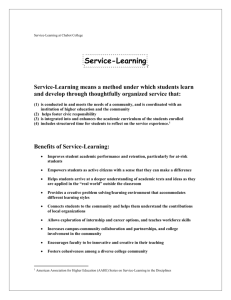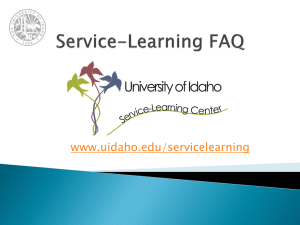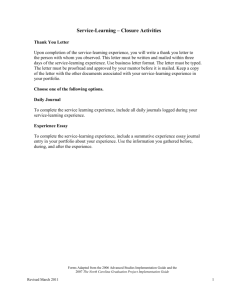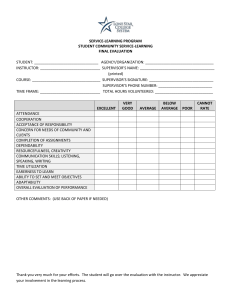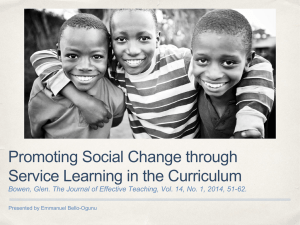Forward! Perspectives from the USA on Service
advertisement
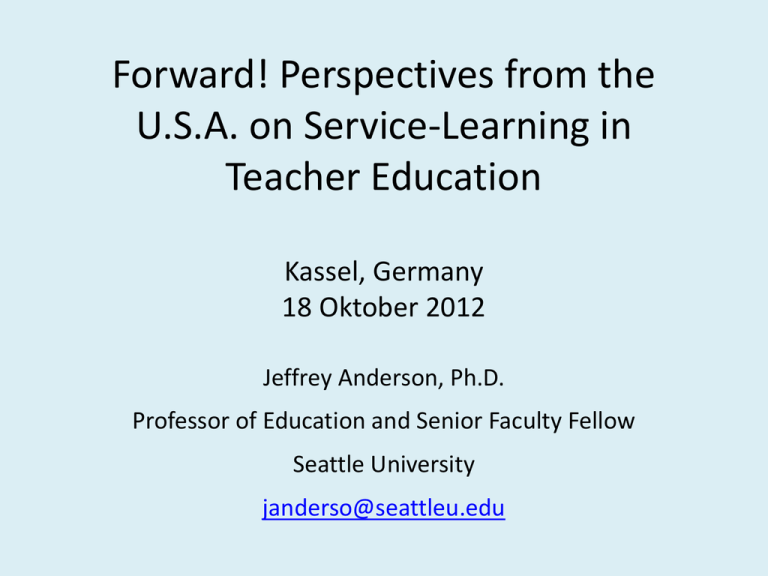
Forward! Perspectives from the U.S.A. on Service-Learning in Teacher Education Kassel, Germany 18 Oktober 2012 Jeffrey Anderson, Ph.D. Professor of Education and Senior Faculty Fellow Seattle University janderso@seattleu.edu Service-Learning (SL) in the USA - 2012 • 93% of higher education institutions offer SL opportunities and 37% of students do SL • More than 1,100 institutional members of Campus Compact • SL is one of only four practices to positively impact retention rate of undergraduates • Growing number of departments and universities have initiated a SL graduation requirement Undergraduate Students’ Views on the Importance of Contributing to the Larger Community 1st year 2nd year 3rd year 4th year Should be a major focus of college 55% 57% 58% 59% Is a major focus of college 45% 42% 41% 38% (American Association of Colleges and Universities Survey, Dey et al, 2009) Service-Learning (SL) in Teacher Education in the USA • In 1998 225 of 1,200 teacher educations programs included SL (19%) • By 2003, 708 of 1,200 included SL (59%) • Preliminary results of a national 2012 survey suggest that this number (708) has remained stable while the quality of SL has continued to improve • In 2010 the National Council for the Accreditation of Teacher Education (NCATE) included SL in its standards as a recommended practice Service-Learning in Teacher Education in the USA 1. Rationales and benefits 2. SL in teacher education contributions to higher education 3. Models of SL integration 4. Foundational issues 5. Research-based moderators of positive outcomes 6. Recommended improvements for the next generation of SL Rationales for the Use of ServiceLearning in Teacher Education • Knowledge and understanding of the community in which their potential K-12 students live (68%) • Understanding and appreciation of human diversity (66%) • Personal and social development (62%) • Teaching self-efficacy (59%) • Civic responsibility and commitment to democratic citizenship (51%) • Clarification of their career goals (43%) • Use of service-learning as a pedagogy (37%) • Understanding of content and skills required by state and national standards (21%) Research on the Impacts of ServiceLearning on Preservice Teachers • Academic learning (5) • Understanding of students and communities (7) • Development of capacities needed to provide equitable, caring instruction (6) • Knowledge of the teaching profession and development of professional skills (8) • Understanding and acceptance of diversity (26) • Knowledge and skills needed to implement service-learning (7) What Teacher Education Brings to Strengthen Service-Learning in Higher Education • Deep community-university relationships • High quality placements • Students well-prepared for engaging other communities (intercultural competence) • Faculty adept at facilitating reflection High Quality SL Placements (Eyler & Giles, 1999) Teacher candidates: • perform challenging tasks • are active rather than observers • perform a variety of tasks • feel that they are making a positive contribution • have important levels of responsibility • receive input and appreciation from supervisors Teacher Candidates are Well Prepared Possess the knowledge, skills, and attitudes needed for success – Intercultural competence • • • • Empathic listeners Non-judgmental Seek multiple viewpoints Build on strengths “TED TALK” Chimananda Adichie “The Danger of a Single Story” http://prezi.com/vfwivdpqsak8/winter-2011seattle-university-service-placement-siteexpectations/ Scenario • A group of five Muslim girls, recent immigrants from Bosnia, ages 14-15, have been regularly attending your class and participating in the class service-learning project for the past four months. The last two weeks they have not been to school even one day and the school has not been able to communicate with their parents by phone or email. • How would you handle this situation? Most Frequently Identified Moderators • Reflection • Service directly related to teaching or course goals • Teacher candidate voice • Interaction with diverse cultures • Teacher candidates well-prepared • Teacher candidates well-supported • Service took place in a “third space” • Variety of service experiences Limitations to the Research Qualitative Studies • Often involve a single class • Instructor serves as researcher/evaluator • Fail to control for faculty members’ potential influence and bias • Limited generalizabiltiy Limitations to the Research Quantitative Studies • Rarely use experimental or quasi-experimental research design (infrequent use of control groups or random assignment) • Usually asses global changes in participants without examining the role played by differences in teacher candidates, programs, or service sites in moderating outcomes Models for the Use of SL in Teacher Education Integrated Model 1. Introduction to Teaching course (tutor children in schools) 2. Social Foundations of Education or Multicultural Education ( tutor in “third space”) 3. Educational Psychology course (present theories, research, rationales for SL) 4. Instructional Methods Courses (teach the pedagogy of SL) 5. Assessment Course (teach methods to assess SL outcomes) 6. Capstone Student Teaching Internship (teacher candidates design and conduct a SL project in a school setting) Pros and Cons of the Integrated Model Pros – Doesn’t take too much time from any one course – Clearly connects SL to the core of the program as a central instructional strategy Cons – Easier for uncommitted instructor to reduce emphasis on SL – SL experiences can be shallow since they are of limited duration Stand Alone Model Develop a separate course focused only on SL that incorporates all the experiences of the six courses in the integrated model into one course. Pros – Insures that all teacher candidates will receive focused, consistent instruction in SL – Difficult to eliminate from program – Usually provides deeper SL experience of greater duration and intensity Cons – Difficult to find room in crowded curriculum for another course – Teacher candidates may see SL as a separate strategy, not central to their role as a teacher – Other teacher education faculty may avoid SL since it is already being done “over there” Distinctions Among Teacher Education Field Experiences (adapted from Furco, 1996) Recipient---------------------------- Beneficiary -------------------------Provider Service-Learning Volunteerism Service-------------------------------- Student Teaching Internship Focus -----------------------------Learning Service-learning’s Needed Improvements 1. Deeper community-university partnerships 2. Adjust the role of the university service-learning center 3. Use more diverse forms of service-learning 4. Develop a service-learning or community engagement major 5. Get serious about community impact 6. Increase student voice 7. Revise promotion and tenure requirements International Center for Service-Learning in Teacher Education educationprogram.duke.edu/ICSLTE International Journal for Research on ServiceLearning in Teacher Education • April 1, 2013 deadline for next issue • Submit to janderso@seattleu.edu “Bildung ist nicht einen Eimer zu fullen, sondern ein Feuer zu entfachen.” --- W.B. Yeats
